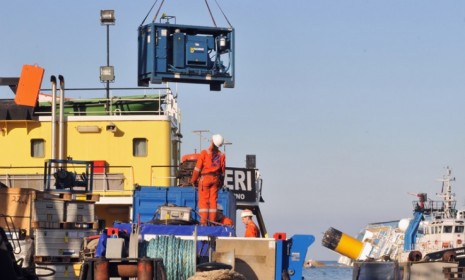Is the wrecked Costa Concordia an 'ecological timebomb'?
The resort town of Giglio watches nervously as cleanup crews prepare to pump thousands of tons of oil from the capsized cruise ship

The capsized Costa Concordia cruise ship that hit a rock just off the Tuscan island of Giglio over the weekend now represents an "ecological time bomb," warns Giglio's mayor. Indeed, says Richard Black at the BBC, "we have a big ship with tanks full of fuel, aground on an island in a sea fringed with natural protected areas." Clearly, "the worst case scenario is pretty bad." How bad? Here's what you should know:
How much fuel is onboard?
The 114,500-ton ship was carrying more than 2,400 tons of fuel in its 17 tanks. "So far, there's good news," says Wendy Koch at USA Today: There's no oil leaking into the sea... at least not yet. But "the race is now on to secure the ship," says Leo Hickman at Britain's Guardian.
The Week
Escape your echo chamber. Get the facts behind the news, plus analysis from multiple perspectives.

Sign up for The Week's Free Newsletters
From our morning news briefing to a weekly Good News Newsletter, get the best of The Week delivered directly to your inbox.
From our morning news briefing to a weekly Good News Newsletter, get the best of The Week delivered directly to your inbox.
How will cleanup crews extract the oil?
"The process involves drilling holes at the highest and lowest points of the tanks and fitting valves to them," says Black at the BBC. Seawater will then "exert pressure from the bottom, forcing the oil up and out of the top valve." Once the fuel is pumped out of the ship, it "will be replaced by water in the tanks to ensure that the ship" remains stable, reports AFP. Officials estimate that the cleanup effort, which will begin as soon as Italy gives the okay, will take three to four weeks, Koch reports. The "big risk in the meantime," says Black, is that the 950-foot ship may begin "breaking up," causing a damaging spill before the oil can be safely extracted.
And the surrounding environment is sensitive?
It's a "major marine sanctuary" — the largest in Italy, says AFP. It's full of rare frogs, gulls, coral, and even "the occasional Mediterranean monk seal — a critically endangered species," Black says. And it's not just wildlife. Giglio itself is famous for its "sandy beaches and rustic charm," and is a "major holiday destination in the summer, when the population swells from around 800 permanent residents to some 5,000 people."
A free daily email with the biggest news stories of the day – and the best features from TheWeek.com
Are there any other risks?
The hulking ship itself could damage the environment, says Koch, particularly "from the refuse it leaves behind." Right now, says one environmental researcher, "it's like a small city moving from one place to another" in the sea. Obviously, the ship has to be removed, Hickman notes. Costa Crociere — the company that owns the vessel — plans to "refloat the ship, then tow it away for possible repairs and reuse." If that fails, the cruise ship "would have to be cut up for scrap, a process that could take months, even years."
Sources: AFP, BBC, The Guardian, Huffington Post, USA Today


